Buying Wood
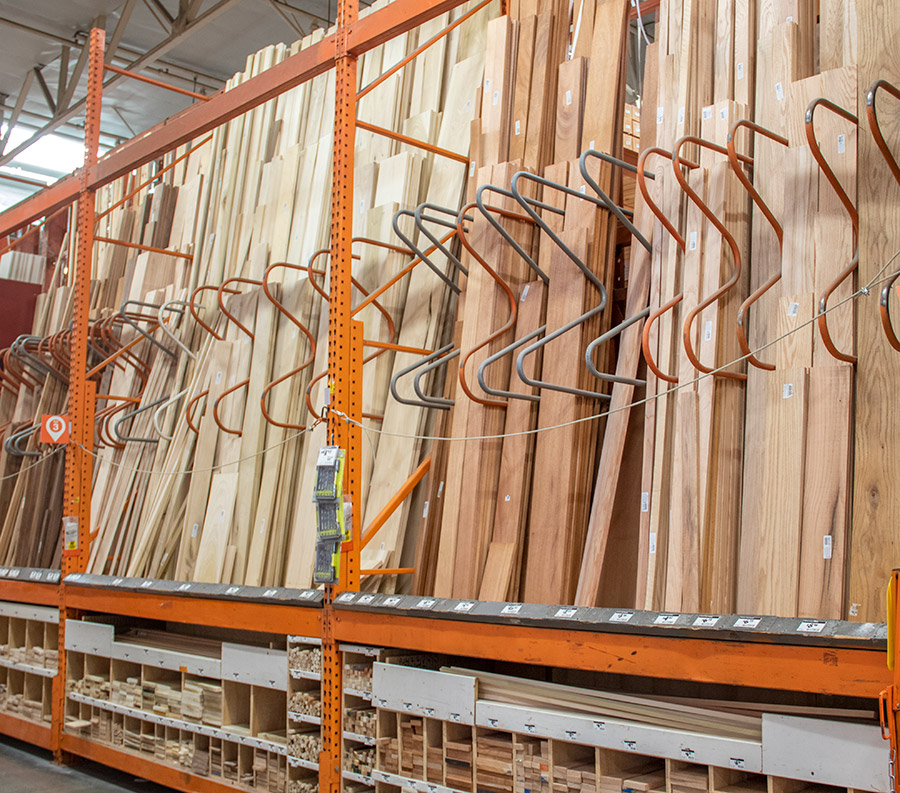 One of the best transitions a woodworker can make is to shift from buying wood at big box stores and start shopping at lumberyards. One advantage of going to big box stores is that the wood is finished on all four sides (S4S = Surfaced Four Sides, which adds to its cost), so it looks ready to go! This may seem like a big convenience for a woodworker, but you are paying for that convenience in more ways than just money.
One of the best transitions a woodworker can make is to shift from buying wood at big box stores and start shopping at lumberyards. One advantage of going to big box stores is that the wood is finished on all four sides (S4S = Surfaced Four Sides, which adds to its cost), so it looks ready to go! This may seem like a big convenience for a woodworker, but you are paying for that convenience in more ways than just money.
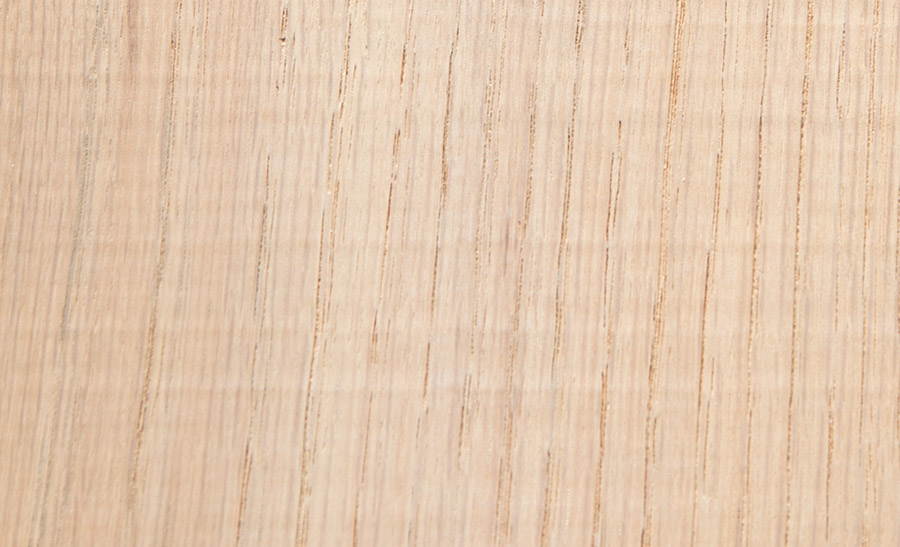 One issue you’ll have to deal with when purchasing wood from a big box store is that the wood will almost invariably have mill marks. Both jointers and planers create these marks as they mill the wood to size. As the wood is pushed past the spinning blades, each blade leaves a scallop-shaped void before the next blade sweeps by.
The boards may also have some warp, bend, twist, or cupping. ALL wood is prone to having these issues. If you purchase the wood at the thickness you need, you don’t have any room left to clean the material up and stay at the thickness you need. For more on warping and bowing see the companion article, “Understanding Wood.”
One issue you’ll have to deal with when purchasing wood from a big box store is that the wood will almost invariably have mill marks. Both jointers and planers create these marks as they mill the wood to size. As the wood is pushed past the spinning blades, each blade leaves a scallop-shaped void before the next blade sweeps by.
The boards may also have some warp, bend, twist, or cupping. ALL wood is prone to having these issues. If you purchase the wood at the thickness you need, you don’t have any room left to clean the material up and stay at the thickness you need. For more on warping and bowing see the companion article, “Understanding Wood.”
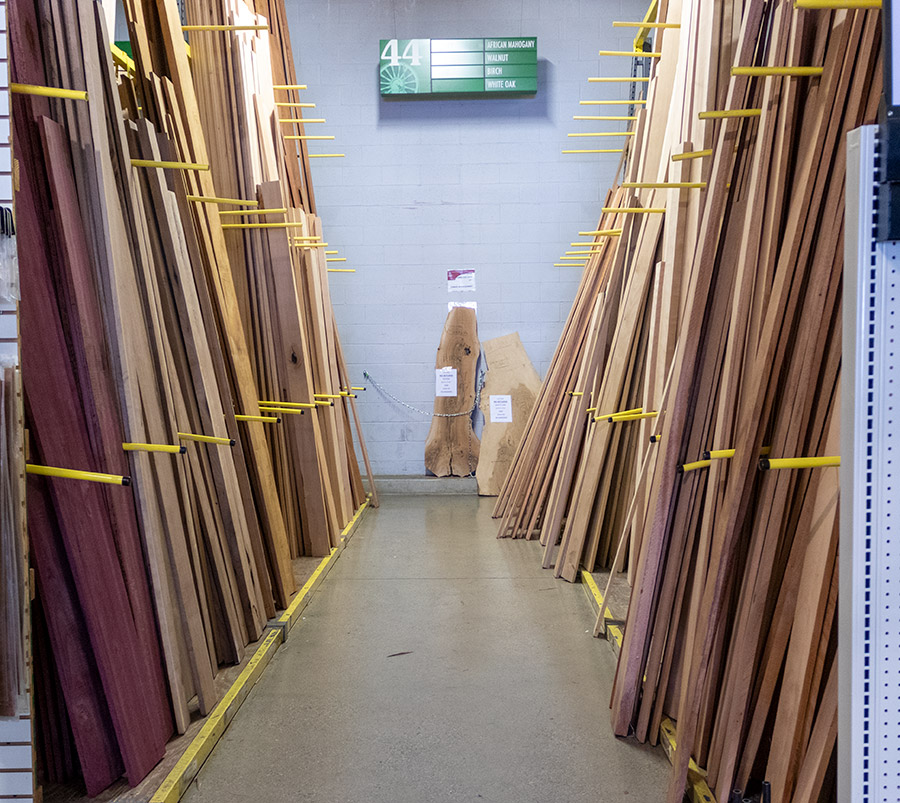 Instead of a big box store, consider making your lumber purchases at a woodworking store or hardwood supplier. These sources give you a lot of advantages. These suppliers have a much wider selection of woods, and the prices will most likely be lower than those at a big box store.
Many woodworking stores sell their material already surfaced, which takes us back to the problem of removing mill marks and warp from the boards, and still having enough thickness to work with. Some suppliers mill to 13/16” thickness instead of 3/4". Look for this option so you have more material to work with.
Instead of a big box store, consider making your lumber purchases at a woodworking store or hardwood supplier. These sources give you a lot of advantages. These suppliers have a much wider selection of woods, and the prices will most likely be lower than those at a big box store.
Many woodworking stores sell their material already surfaced, which takes us back to the problem of removing mill marks and warp from the boards, and still having enough thickness to work with. Some suppliers mill to 13/16” thickness instead of 3/4". Look for this option so you have more material to work with.
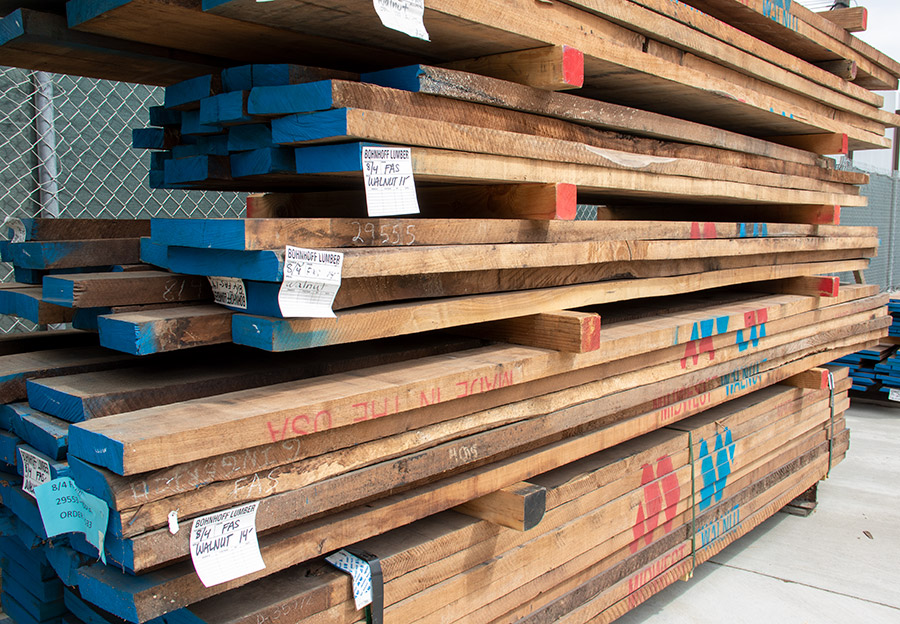 Woodworkers are better off going to a place that sells rough sawn lumber. This means the material hasn’t been surfaced or cleaned up at all.
If you need it, almost all lumber yards also provide basic milling services (for a fee). If you do have the lumber yard do the initial milling, have them bring it almost down to the desired size so you can remove their milling marks.
To talk the talk, you need to know that hardwood thickness is measured in quarters. A 1” thick board is called 4/4, 1-1/2” thick is 6/4, and so on. Additionally, these suppliers typically sell wood by the board foot.
If you buy rough sawn wood at 4/4, you have the luxury of removing the outside of the board to obtain the 3/4” board you need, but you’ll need a planer to do it (preferably a planer AND jointer). Planers and jointers perform very different functions. There’s a distinct sequence you should follow when squaring up lumber. Thus, for the opportunity to save money on wood, you do need to spend money on new equipment, assuming your shop has room for that equipment. However, check with local woodworking clubs, as some members might be willing to help mill your lumber for you (offer to buy them lunch?). Also, check if any local woodworking community workspaces provide access to large equipment for a monthly fee.
Woodworkers are better off going to a place that sells rough sawn lumber. This means the material hasn’t been surfaced or cleaned up at all.
If you need it, almost all lumber yards also provide basic milling services (for a fee). If you do have the lumber yard do the initial milling, have them bring it almost down to the desired size so you can remove their milling marks.
To talk the talk, you need to know that hardwood thickness is measured in quarters. A 1” thick board is called 4/4, 1-1/2” thick is 6/4, and so on. Additionally, these suppliers typically sell wood by the board foot.
If you buy rough sawn wood at 4/4, you have the luxury of removing the outside of the board to obtain the 3/4” board you need, but you’ll need a planer to do it (preferably a planer AND jointer). Planers and jointers perform very different functions. There’s a distinct sequence you should follow when squaring up lumber. Thus, for the opportunity to save money on wood, you do need to spend money on new equipment, assuming your shop has room for that equipment. However, check with local woodworking clubs, as some members might be willing to help mill your lumber for you (offer to buy them lunch?). Also, check if any local woodworking community workspaces provide access to large equipment for a monthly fee.
 Before visiting a hardwood supplier, double check if they’ll allow you to hand-pick your boards. They may not. Some suppliers simply ask you how many board feet you want, and they pick the order for you. Though you may pay more per board foot at a woodworking store, you’ll probably be able to hand-pick the boards you need.
Before visiting a hardwood supplier, double check if they’ll allow you to hand-pick your boards. They may not. Some suppliers simply ask you how many board feet you want, and they pick the order for you. Though you may pay more per board foot at a woodworking store, you’ll probably be able to hand-pick the boards you need.
Defects in Wood and the Wood Grading System
 As stated in the previous section, a board’s warpage can cause many issues. Defects in the wood can be issues as well. The NHLA (National Hardwood Lumber Association) has developed standards to grade wood. This is important because lumber is not man-made. Even if the wood was grown on a tree farm, they are a product of nature—and nature is not always consistent.
There are four grades for lumber:
As stated in the previous section, a board’s warpage can cause many issues. Defects in the wood can be issues as well. The NHLA (National Hardwood Lumber Association) has developed standards to grade wood. This is important because lumber is not man-made. Even if the wood was grown on a tree farm, they are a product of nature—and nature is not always consistent.
There are four grades for lumber:
- FAS
- FAS 1 Face and Select
- No. 1 Common
- No. 2 & 3 Common
These represent how much viable board you can get from a single board. The easiest way to understand this is by looking at the following chart. Buy a higher grade, pay more money for it, and get more material that’s clear of defects.How Wood Gets Graded
So, the way this works, the inspectors look for regions of uninterrupted wood—the fewer interruptions, the better the board's quality (and the more expensive). If you typically make small projects like toys, #1 Common is probably fine for you because you only need small pieces. If you routinely make larger projects, you’ll probably have less waste by buying a better grade.
Understand that it’s not about wood quality. FAS red oak is the same quality material as #1 Common red oak. It’s about the size of the pieces you can expect to get and the percentage of a board that’s clear of defects.
If you typically make small projects like toys, #1 Common is probably fine for you because you only need small pieces. If you routinely make larger projects, you’ll probably have less waste by buying a better grade.
Understand that it’s not about wood quality. FAS red oak is the same quality material as #1 Common red oak. It’s about the size of the pieces you can expect to get and the percentage of a board that’s clear of defects.
Finding Suppliers
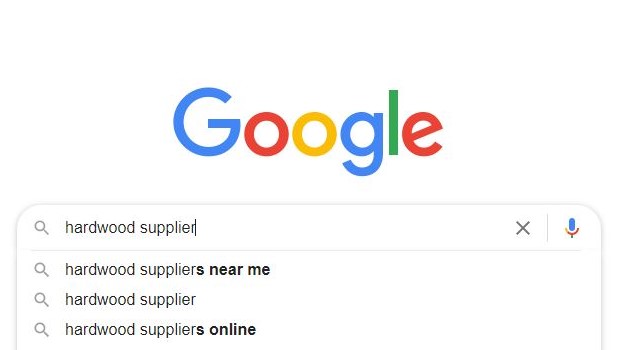 Where can you do this more specialized shopping? The internet is a good place to start with a search for “hardwood suppliers.” This typically provides more focused results than “lumber yard,” which will probably provide you with places to buy construction material, not furniture material.
Next, see if there are woodworking clubs near you. If so, join them, and ask where they get their wood. You can also try calling a few cabinet shops and asking them where they get their material.
I’m fortunate to have one lumber yard close to me where I can go and select any board that appeals to me. It doesn’t make a difference if I buy one board or 50—they charge by the board foot, and that’s it. In other words, it’s great to be able to select your boards, so be sure to ask if that’s possible. If you’re new to selecting boards, ask a knowledgeable friend to join you; it doesn’t take long to learn.
Some places sell lumber online, and you might find wood for sale on sites like eBay or Craigslist. If the wood must be shipped, make sure to ask about the return policy before putting your money down.
Where can you do this more specialized shopping? The internet is a good place to start with a search for “hardwood suppliers.” This typically provides more focused results than “lumber yard,” which will probably provide you with places to buy construction material, not furniture material.
Next, see if there are woodworking clubs near you. If so, join them, and ask where they get their wood. You can also try calling a few cabinet shops and asking them where they get their material.
I’m fortunate to have one lumber yard close to me where I can go and select any board that appeals to me. It doesn’t make a difference if I buy one board or 50—they charge by the board foot, and that’s it. In other words, it’s great to be able to select your boards, so be sure to ask if that’s possible. If you’re new to selecting boards, ask a knowledgeable friend to join you; it doesn’t take long to learn.
Some places sell lumber online, and you might find wood for sale on sites like eBay or Craigslist. If the wood must be shipped, make sure to ask about the return policy before putting your money down.

Plywood
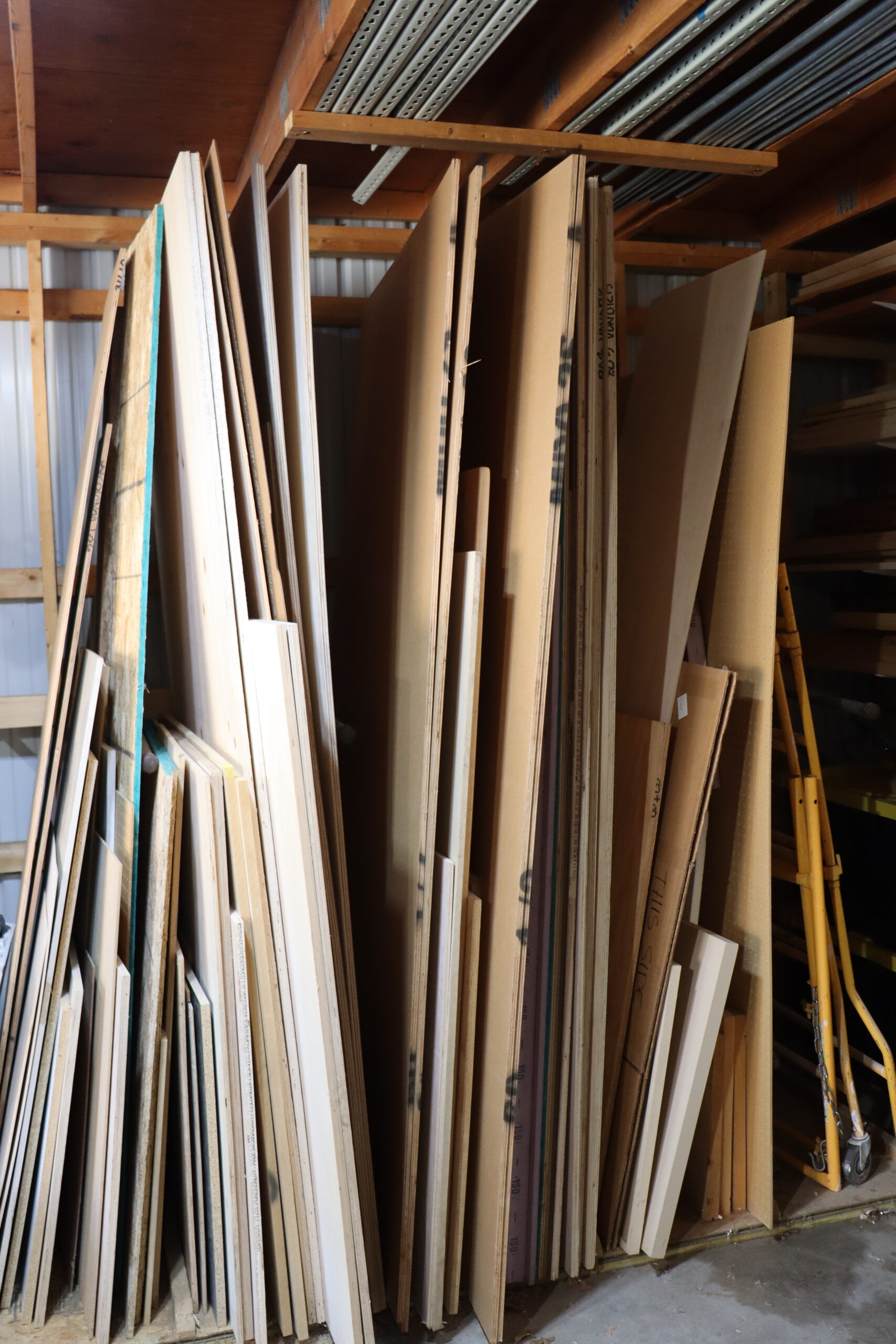 Plywood plays a big part in many projects. Knowing the different kinds of plywood available may help you save money and make stronger projects.
Among plywood’s advantages is that it is dimensionally stable. It does not expand or contract with changes in the season. Plywood is also uniformly strong in width and length because it’s made with thin layers of wood, each layer 90° from the other. Plus, per square foot, it generally costs less than solid wood.
Plywood can be from 1/8” to ¾” thick and typically comes in 4’ x 8’ sheets, so laying out cutting plans leaves the user with many options. It’s very flat and extremely uniform in thickness.
Among plywood’s disadvantages is that, unless it’s exterior grade, it doesn’t do well if it gets wet. Depending on the kind of plywood you purchase, damage can include sheet separation and warping. In the shop, carrying around full sheets alone can be difficult, and for applications where an edge of the plywood is visible, you have to hide or cover the edge. Despite the disadvantages, it’s an important material in any woodworker’s shop.
Read on and you’ll learn about three different kinds of plywood: softwood plywood, hardwood plywood, and multi-ply. A more detailed description of each is provided below.
You’ll see a few comments mentioning that some types of plywood have outside adhesives. This does not mean you do not need to put a finish on these projects. Wood projects always need a finish protection, whether paint, varnish, or epoxy. However, if the plywood has an outside adhesive, it can withstand outdoor conditions better than other types of plywood—sort of like how some watches are water resistant but not waterproof.
Plywood plays a big part in many projects. Knowing the different kinds of plywood available may help you save money and make stronger projects.
Among plywood’s advantages is that it is dimensionally stable. It does not expand or contract with changes in the season. Plywood is also uniformly strong in width and length because it’s made with thin layers of wood, each layer 90° from the other. Plus, per square foot, it generally costs less than solid wood.
Plywood can be from 1/8” to ¾” thick and typically comes in 4’ x 8’ sheets, so laying out cutting plans leaves the user with many options. It’s very flat and extremely uniform in thickness.
Among plywood’s disadvantages is that, unless it’s exterior grade, it doesn’t do well if it gets wet. Depending on the kind of plywood you purchase, damage can include sheet separation and warping. In the shop, carrying around full sheets alone can be difficult, and for applications where an edge of the plywood is visible, you have to hide or cover the edge. Despite the disadvantages, it’s an important material in any woodworker’s shop.
Read on and you’ll learn about three different kinds of plywood: softwood plywood, hardwood plywood, and multi-ply. A more detailed description of each is provided below.
You’ll see a few comments mentioning that some types of plywood have outside adhesives. This does not mean you do not need to put a finish on these projects. Wood projects always need a finish protection, whether paint, varnish, or epoxy. However, if the plywood has an outside adhesive, it can withstand outdoor conditions better than other types of plywood—sort of like how some watches are water resistant but not waterproof.
Softwood Plywood (Construction-Grade Plywood)
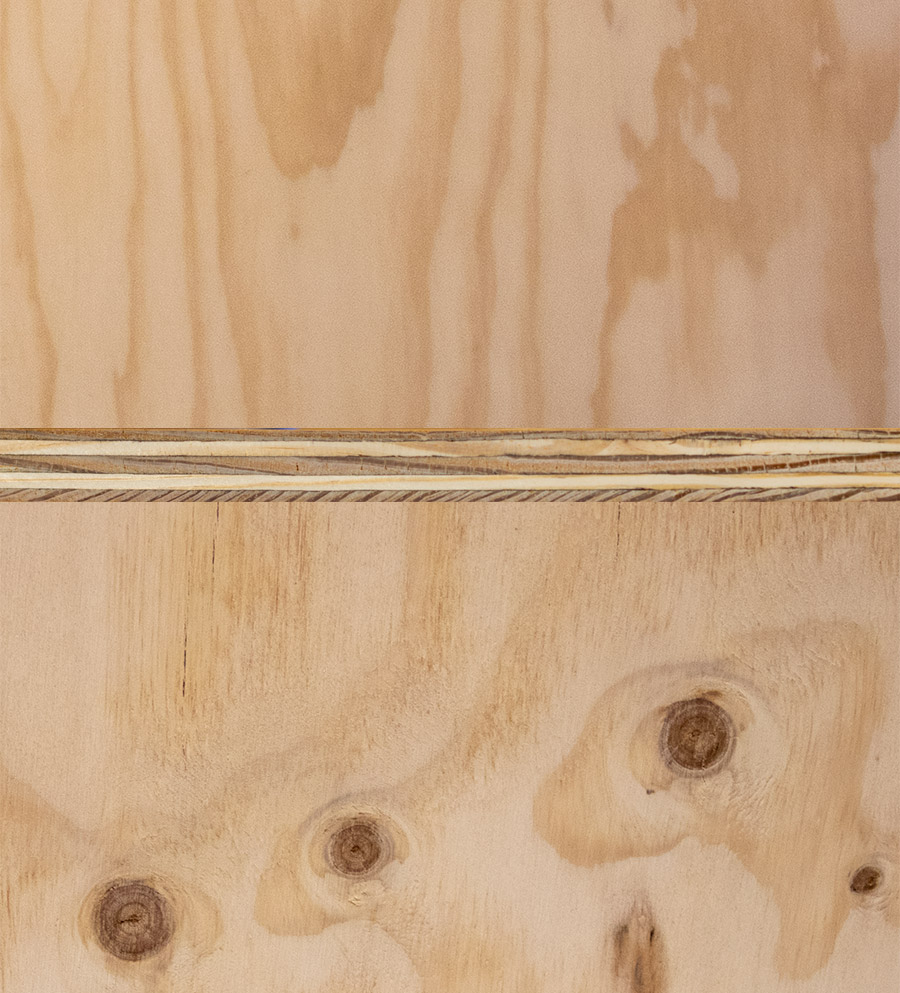 Softwood plywood (also called construction grade plywood) is what you’ll mostly find at a big box store. What distinguishes softwood plywood is that the wood seen on both faces is a softwood and is always radially cut. This softwood is usually cedar, Douglas fir, pine, spruce, redwood, etc. Also, the woods making up the core of the plywood are all softwoods and may or may not be the same type of wood as the outside faces.
There are five different grades of softwood plywood used for different purposes. Note that all of these are focused on construction purposes. That doesn’t mean you cannot use them for woodworking projects, but keep in mind that you may not get the results you were hoping for.
Softwood plywood (also called construction grade plywood) is what you’ll mostly find at a big box store. What distinguishes softwood plywood is that the wood seen on both faces is a softwood and is always radially cut. This softwood is usually cedar, Douglas fir, pine, spruce, redwood, etc. Also, the woods making up the core of the plywood are all softwoods and may or may not be the same type of wood as the outside faces.
There are five different grades of softwood plywood used for different purposes. Note that all of these are focused on construction purposes. That doesn’t mean you cannot use them for woodworking projects, but keep in mind that you may not get the results you were hoping for.
- Exterior: These sheets have been waterproofed and can withstand exposure to the outside weather.
- Exposure 1: Similar to Exterior but not intended to remain bare for an extended period of time.
- Exposure 2: These are made with glue that can withstand limited weather but are primarily intended for interior use.
- Interior: For interior use only and should not be used outside.
- Structural: Typically used for earthquake strengthening.
Softwood plywood is graded as AB, BB, BC, etc. Higher quality faces get an “A,” while the lowest quality receives a “D.” What determines quality is the general appearance of the wood and the number of knots, repairs, or other blemishes.Hardwood Plywood
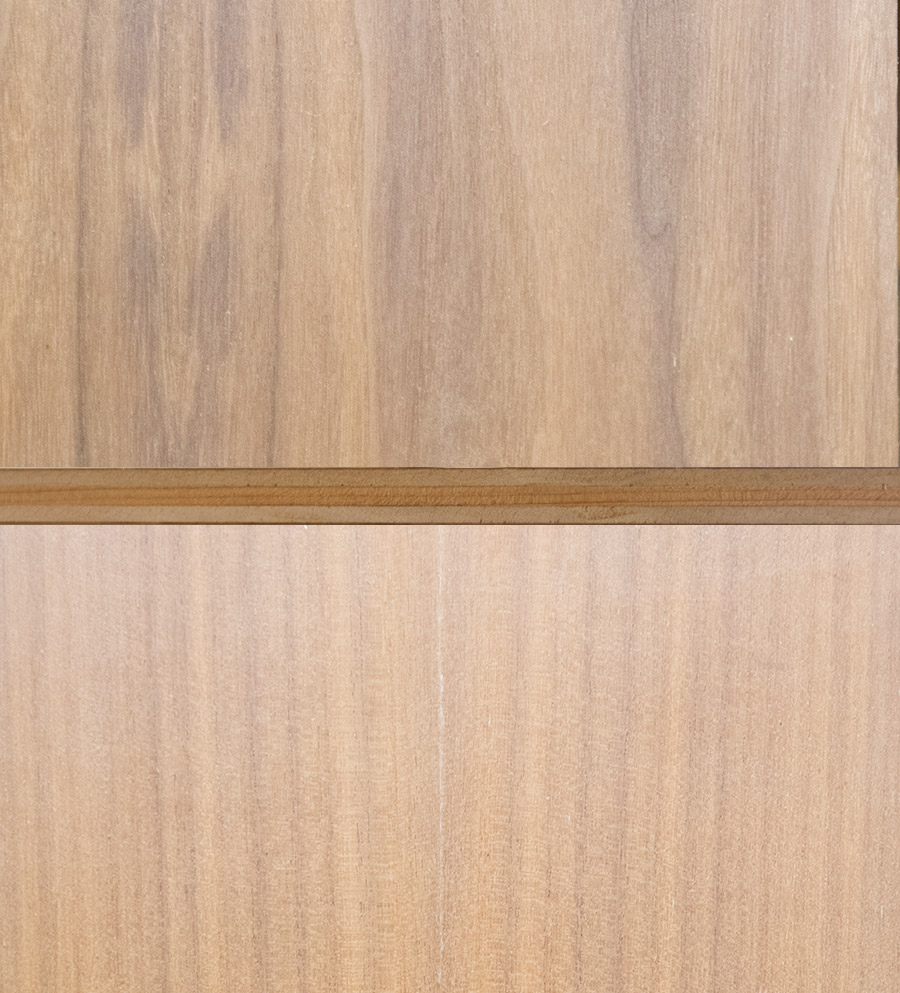 Hardwood plywood only has hardwood on the outer surfaces of the plywood. Any time you see walnut-faced plywood, white oak-faced plywood, or any hardwood species-faced plywood, that’s hardwood plywood. These are intended for woodworking to display the chosen wood or as a surface that will accept paint much better than softwood plywood. The core (inside layers) can either be hardwood, softwood, or MDF (medium-density fiberboard). If you do plan on painting the surface, don’t waste your money on expensive species.
The surface veneer for hardwood plywood can be about 1/30” thick. However, this thickness can be considerably thinner if you get your hardwood-faced plywood at a big box store. Considerable care must be taken when sanding so you don’t sand through the veneer.
Most hardwood plywood is not exterior grade, unless specified as such.
Hardwood plywood grading is represented as A1, B2, or B3. The letter grade is the same as softwood plywood, but hardwood’s back face rating numbers go from best (1) to worst (4). Use discretion when buying because As and 1s will cost more than Ds and 4s. Thus, consider how the plywood will be used in the project before purchasing.
Hardwood plywood only has hardwood on the outer surfaces of the plywood. Any time you see walnut-faced plywood, white oak-faced plywood, or any hardwood species-faced plywood, that’s hardwood plywood. These are intended for woodworking to display the chosen wood or as a surface that will accept paint much better than softwood plywood. The core (inside layers) can either be hardwood, softwood, or MDF (medium-density fiberboard). If you do plan on painting the surface, don’t waste your money on expensive species.
The surface veneer for hardwood plywood can be about 1/30” thick. However, this thickness can be considerably thinner if you get your hardwood-faced plywood at a big box store. Considerable care must be taken when sanding so you don’t sand through the veneer.
Most hardwood plywood is not exterior grade, unless specified as such.
Hardwood plywood grading is represented as A1, B2, or B3. The letter grade is the same as softwood plywood, but hardwood’s back face rating numbers go from best (1) to worst (4). Use discretion when buying because As and 1s will cost more than Ds and 4s. Thus, consider how the plywood will be used in the project before purchasing.
Multi-Ply Plywood
 Multi-ply plywood is receiving a special call-out because it is used in the woodworking shop for projects, jigs, fixtures, furniture. Many woodworkers refer to all multi-ply plywood as Baltic Birch, like referring to all facial tissues as Kleenex. Another form of multi-ply plywood is ApplePly.
In multi-ply plywood, each layer is thinner (about 1.5 mm) than standard plywood and is made of hard, strong wood, making this type of plywood especially strong and excellent for furniture construction. A huge benefit of multi-ply is that it never has internal voids.
Since Baltic Birch typically comes from Europe, it’s sold in metric thicknesses as 3mm, 6mm, 9mm, etc., up to 25mm. Because 3mm is very close to 1/8”, each thickness step coincides with 1/8”, 1/4”, 3/8”, etc., up to 1”. Besides the thickness dynamic, it is sold in either 5’ x 5’ (or, more specifically, 1525 mm x 1525 mm) sheets or in 4’ x 8’ sheets. This depends upon where your supplier is getting their supplies.
Like other plywood, it also uses a front/back identifier for quality. The highest grade is “B,” then “BB,” and “CP,” with the lowest grade being “C.” Baltic Birch plywood is typically sold as B/BB. That means the face side is good with no defects, but the backside is not quite as good.
Multi-ply plywood is receiving a special call-out because it is used in the woodworking shop for projects, jigs, fixtures, furniture. Many woodworkers refer to all multi-ply plywood as Baltic Birch, like referring to all facial tissues as Kleenex. Another form of multi-ply plywood is ApplePly.
In multi-ply plywood, each layer is thinner (about 1.5 mm) than standard plywood and is made of hard, strong wood, making this type of plywood especially strong and excellent for furniture construction. A huge benefit of multi-ply is that it never has internal voids.
Since Baltic Birch typically comes from Europe, it’s sold in metric thicknesses as 3mm, 6mm, 9mm, etc., up to 25mm. Because 3mm is very close to 1/8”, each thickness step coincides with 1/8”, 1/4”, 3/8”, etc., up to 1”. Besides the thickness dynamic, it is sold in either 5’ x 5’ (or, more specifically, 1525 mm x 1525 mm) sheets or in 4’ x 8’ sheets. This depends upon where your supplier is getting their supplies.
Like other plywood, it also uses a front/back identifier for quality. The highest grade is “B,” then “BB,” and “CP,” with the lowest grade being “C.” Baltic Birch plywood is typically sold as B/BB. That means the face side is good with no defects, but the backside is not quite as good.
Final Words
Suppliers that sell quality hardwoods are generally also good places to shop for better-quality sheet goods. There are MANY more sheet stock options available, such as melamine, MDF, particle board, or MDO. They all have their place in woodworking shops, but these forms of plywood are the most prevalent. Last, just about any place selling wood or plywood will cut what you’ve purchased down to a size that will fit your vehicle for free, or for a nominal charge. Knowing the minimum size you’ll need for your project is essential. Otherwise, the wood will fit in your vehicle but might turn out to be too small for your project. What they will not do is cut all your pieces down to size for your project for free. You can expect to pay for this service if you need them to do that.

What about "sycamore or plane tree "wood?
note: under" MULTI-PUY PLYWOOD you have "1/8", 14", 3/8. I think that should be 1/4" not 14"
You can also prepare your using hand planes and then don't require a planer.